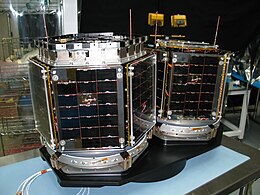3 Corner Satellite

Two 3CS satellites undergoing testing
|
|
| Country of origin | United States |
|---|---|
| Operator | CU-Boulder, ASU, NMSU, AFRL, STP |
| Applications | Technology demonstration |
| Specifications | |
| Design life | 2-4 months |
| Regime | Low Earth (planned) |
| Production | |
| Status | Failed |
| Built | 3 |
| Launched | 2 |
| Lost | 2 |
| First launch |
Ralphie/Sparkie December 21, 2004 Failed to orbit |
Three Corner Satellite (or 3CS, or 3CornerSat) consists of three student-built microsatellites flying in formation. Primary mission objectives were to demonstrate formation flying, provide stereoscopic imaging of cloud formations, and demonstrate distributed and autonomous operations.
A pair of spacecraft, Ralphie and Sparkie, was developed by the University of Colorado at Boulder and Arizona State University as part of the Air Force Research Laboratory's University Nanosat Program. A third satellite, Petey, developed by New Mexico State University was originally also part of the 3CS but was not completed in time for launch.
The 3CS stack was originally slated for launch aboard the Space Shuttle in 2003, but after Shuttle Columbia tragedy, mission organizers switched to Boeing Delta IV Heavy rocket (it was its first launch). Due to a problem with the rocket during launch, 3CS failed to achieve orbit. Satellites were to have been dropped off at a low 180 km × 240 km, but they entered orbit at a height of only 105 km, which led to a rapid decay.
Primary mission objectives:
Secondary mission objectives:
The spacecraft were equipped with robust execution management software (Spacecraft Command Language (SCL), Continuous Activity Scheduling Planning Execution and Replanning (CASPER) software, Context-sensitive anomaly detection software (SELMON monitoring system)
...
Wikipedia
